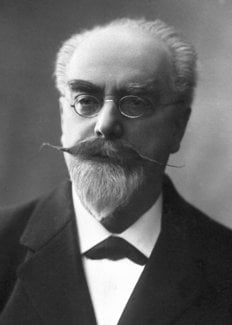Gabriel Lippmann
Biographical

Gabriel Lippmann was born of French parents at Hollerich, Luxembourg on August 16, 1845. The family moved to Paris and he received his early education at home. In 1858 he entered the Lycée Napoleon and ten years later he was admitted to the École Normale. His school career was not markedly successful, for he concentrated only on the work which interested him and neglected that which did not appeal to his taste, and he failed the examination which would have qualified him as a teacher. In 1873, he was appointed to a Government scientific mission visiting Germany to study methods for teaching science: he worked with Kühne and Kirchhoff in Heidelberg and with Helmholtz in Berlin.
Lippmann joined the Faculty of Science in Paris in 1878 and in 1883 he was appointed Professor of Mathematical Physics. Three years later he became Professor of Experimental Physics, succeeding Jamin, and he was appointed Director of the Research Laboratory which was subsequently transferred to the Sorbonne. He retained this position until his death.
Lippmann, of original and independent mind, made many valuable fundamental contributions to many different branches of physics, especially electricity, thermodynamics, optics and photochemistry. In Heidelberg he studied the relationship between electrical and capillary phenomena: this led to the development, amongst other instruments, of his extraordinarily sensitive capillary electrometer.
Professor Lippmann had evolved the general theory of his process for the photographic reproduction of colour in 1886 but the practical execution presented great difficulties. However, after years of patient and skilful experiment, he was able to communicate the process to the Academy of Sciences in 1891, although the photographs were somewhat defective due to the varying sensitivity of the photographic film. In 1893, he was able to present to the Academy photographs taken by A. and L. Lumière in which the colours were produced with perfect ortho-chromatism. He published the complete theory in 1894.
In 1895, Lippmann evolved a method of eliminating the personal equation in measurements of time, using photographic registration, and he studied the eradication of irregularities of pendulum clocks, devising a method of comparing the times of oscillation of two pendulums of nearly equal period. He contributed to astronomy with his invention of the coelostat, a device which immobilizes the image of a star and its surrounding stars so that a photograph may be taken. He was also responsible for many more ingenious devices and improvements to standard instruments to the benefit of many branches of physics.
His work is mainly recorded in communications to the Paris Academy of Sciences where his papers are noted for their conciseness and originality. His method of reproducing colours in photography, based on the interference phenomenon, gained him the Nobel Prize for Physics for 1908.
Professor Lippmann became a member of the Academy of Sciences in 1886 and served as its President in 1912. He was a member of the Board of the Bureau des Longitudes and a Foreign Member of the Royal Society of London.
In 1888 Lippmann married the daughter of the writer V. Cherbuliez, member of the French Academy.
He died at sea on July 13, 1921, during his return from a journey to North America as a member of a mission headed by Marshal Fayolle.
This autobiography/biography was written at the time of the award and first published in the book series Les Prix Nobel. It was later edited and republished in Nobel Lectures. To cite this document, always state the source as shown above.
The Nobel Foundation's copyright has expired.Nobel Prizes and laureates
Six prizes were awarded for achievements that have conferred the greatest benefit to humankind. The 12 laureates' work and discoveries range from proteins' structures and machine learning to fighting for a world free of nuclear weapons.
See them all presented here.
